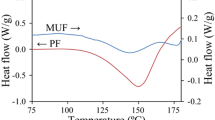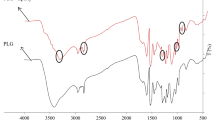Abstract
The effect of addition of Acacia mangium bark powder on the thermosetting processes of two commercial phenol resins, PF-A and PF-B, was examined by bond strength test, torsional braid analysis, and differential scanning calorimetry. When the bark powder was added to PF-A, the bond strength of plywood pressed at 110°C increased and was comparable to that of plywood pressed at 120 and 130°C. However, when the bark powder was added to PF-B, the bond strength of plywood pressed at 110°C was still lower than that of plywood pressed at 120 and 130°C. The relative rigidity and loss tangent of PF-A cured with the bark powder obtained by heating at 100°C were comparable to those at 120 and 140°C, and the reaction enthalpy was increased by bark powder addition. In contrast, chemical reactions for cured PF-B were not enhanced by bark powder addition.



Similar content being viewed by others
References
Hamada R, Ikeda S, Satake Y (1969) Utilization of wood bark for plywood adhesive. I. Effect of addition of bark of Acacia mollissima on the properties of phenol formaldehyde resin (in Japanese). Mokuzai Gakkaishi 15:165–170
Holopainen T, Alvila L, Rainio J, Pakkanen TT (1997) Phenol-formaldehyde resol resins studied by 13C-NMR spectroscopy, gel permeation chromatography, and differential scanning calorimetry. J Appl Polym Sci 66:1183–1193
JIS K 6833 (1994) General testing methods for adhesives. Japanese Standards Association (JSA), Tokyo
Kenny JM, Pisaniello G, Farina F, Puzziello S (1995) Calorimetric analysis of the polymerization reaction of a phenolic resin. Thermochim Acta 269/270:201–211
King PW, Mitchell RH, Westwood AR (1974) Structural analysis of phenolic resole resins. J Appl Polym Sci 18:1117–1130
Kissinger H (1957) Reaction kinetics in differential thermal analysis. Anal Chem 29:1702–1706
Lippmaa H, Samoson A (1988) Solid-state 13C NMR study of cured resorcinol-formaldehyde resins. J Adhes Soc Jpn 24:300–306
McCoy JPA (1918) US Patent 1269627
Ogawa S, Susanti CME, Yano H (2002) Direct utilization of Acacia mangium bark as water proof adhesives. In: Proceedings of the fourth international wood science symposium, Serpong, Indonesia, pp 182–187
Park B-D, Riedl B, Hsu EW, Shields J (1998) Effects of weight average molecular mass of phenol-formaldehyde adhesives on medium density fiberboard performance. Holz Roh Werkst 56:155–161
Park B-D, Riedl B, Bae H-J, Kim YS (1999) Differential scanning calorimetry of phenol-formaldehyde (PF) adhesives. J Wood Chem Technol 19:265–286
Philips EK, Detlefsen WD, Carlson FE (1991) Techniques for bonding high moisture content wood in oriented strand board with phenol–formaldehyde resin. In: Maloney TM (ed) Proceedings, 25th international particleboard/composite materials symposium, Washington, pp 231–248
Pizzi A (1983) Tannin-based wood adhesives. In: Pizzi A (ed) Wood adhesives chemistry and technology. Marcel Dekker, New York, pp 177–246
Rossouw DT, Pizzi A, McGillivray G (1980) The kinetics of condensation of phenolic polyflavonoid tannins with aldehydes. J Polym Sci Polym Chem Ed 18:3323–3343
Vázquez G, González-Álvarez J, López-Suevos F, Freire S, Antorrena G (2002) Curing kinetics of tannin-phenol-formaldehyde adhesives as determined by DSC. J Therm Anal Calorim 70:19–28
Werstler DD (1986) Quantitative 13C n.m.r. characterization of aqueous formaldehyde resins: 1. Phenol-formaldehyde resins. Polymer 27:750–756
Yano H, Ogawa S, Kawai S, Inai A, Homma Y, Yamauchi H, Nasu H, Yamazaki M, Yada G (2005) Manufacturing and utilization for wood adhesives of Acacia mangium bark powder (in Japanese). Mokuzai-kogyo 60:478–482
Yazaki Y, Collins PJ (1998) A novel tannin extraction from radiata pine bark for high quality wood adhesives. In: Proceedings of the fourth Pacific rim bio-based composites symposium, Bogor, Indonesia, pp 19–26
Yazaki Y, Hill WE (1980) Molecular size distribution of radiata pine bark extracts and its effect on properties. Holzforschung 34:125–130
Yazaki Y, Morita S, Collins PJ (1998) Potential use of Acacia mangium bark for waterproof wood adhesives. In: Proceedings of the fourth Pacific rim bio-based composites symposium, Bogor, Indonesia, pp 36–44
Acknowledgments
We express our sincere gratitude to Koshii & Co. Ltd. for providing the A. mangium bark powder. We also thank Professor Tsuda, Asahikawa National College of Technology, for his support during the NMR measurements and Mr. Yoshida, Hokkaido Industrial Research Institute, for his support during the DSC measurements.
Author information
Authors and Affiliations
Corresponding author
Rights and permissions
About this article
Cite this article
Miyazaki, J., Hirabayashi, Y. Effect of the addition of Acacia mangium bark on thermosetting of phenol–formaldehyde resin. Wood Sci Technol 45, 449–460 (2011). https://doi.org/10.1007/s00226-010-0342-6
Received:
Published:
Issue Date:
DOI: https://doi.org/10.1007/s00226-010-0342-6




